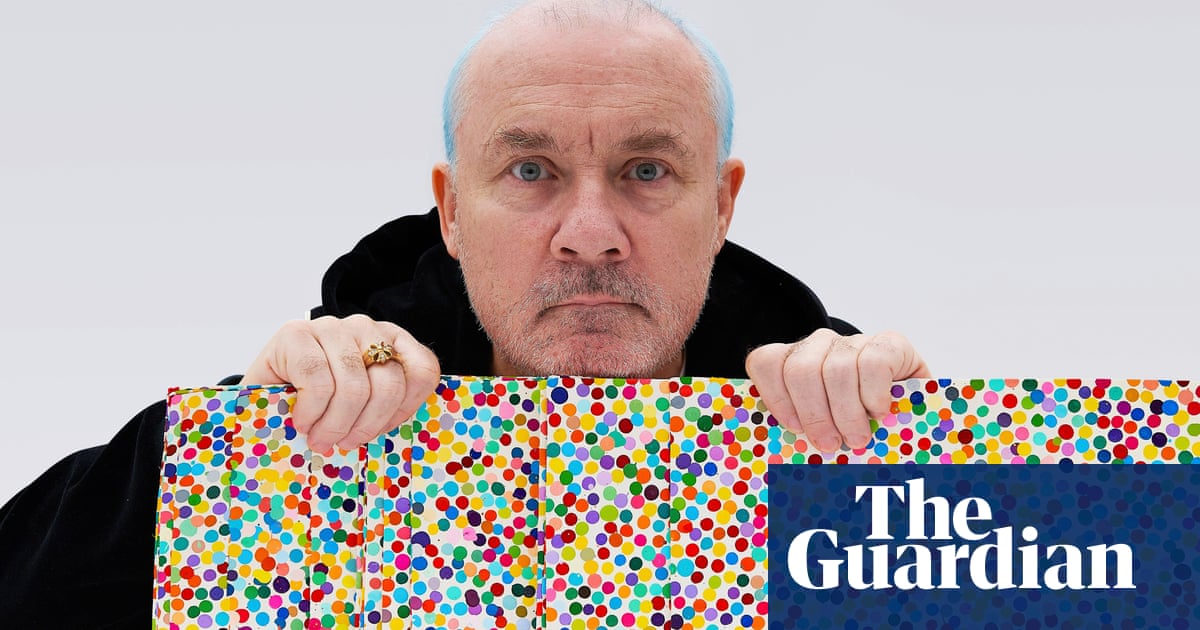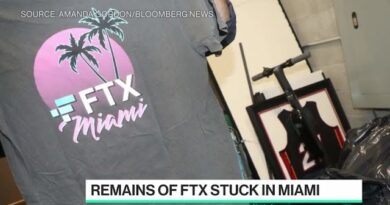
At least 1,000 Damien Hirst artworks were painted years later than claimed | Damien Hirst

At least 1,000 paintings that the artist Damien Hirst said were “made in 2016” were created several years later, the Guardian can reveal.
Hirst produced 10,000 of the paintings, each comprising colourful hand-painted dots on A4 paper, as part of a project called The Currency that was born from the idea of creating a form of money from art.
The year 2016 was inscribed on the works beside the artist’s signature. Hirst and the authorised seller of the paintings repeatedly said the physical works were created in 2016.
When they went on sale in 2021, in a high-profile event at which buyers were given the option of acquiring a permanent digital record of the paintings in the form of a non-fungible token (NFT), Hirst said it was “the most exciting project I have ever worked on by far”.
The initial sale brought in about $18m. At the time, Hirst said of the project: “It comprises of 10,000 NFTs, each corresponding to a unique physical artwork made in 2016.”
The paintings were sold via a single authorised seller, Heni, run by Hirst’s business manager. It said at the time that the works were “created by hand in 2016”.
Gallery staff at the preview showing of The Currency collection. Photograph: Stephen Chung/Alamy
However, five sources familiar with the creation of the works, including some of the painters who put the dots to paper, told the Guardian many of them were mass-produced in 2018 and 2019.
Their accounts suggest at least 1,000 – and possibly several thousand – paintings in The Currency series were made during the two-year period. They were produced by dozens of painters hired at Hirst’s company Science Ltd at two studios, in Gloucestershire and London, in what one source described as a “Henry Ford production line”.
Each painting was marked with a microdot, an embossed stamp of authenticity and a pencil-written title, date and signature on the back. Dates attributed to artworks are widely understood to refer to the year they were completed.
Contacted for comment, lawyers for Hirst and Science did not dispute that at least 1,000 of the paintings the artist said were dated 2016 were painted several years later. They did not respond to questions about why Hirst had explicitly said the physical artworks had been “made in 2016”.
However, they denied Hirst had been deliberately misleading, arguing that it was his “usual practice” to date physical works in a conceptual art project with the date of the project’s conception, which in the case of The Currency was 2016.
A painting with the year 2016 on the back. A hologram watermark is also visible and part of the artist’s signature. Photograph: Guy Bell/Alamy
Hirst and Science used a similar argument in March, after the Guardian revealed that several well-known formaldehyde sculptures made by pickling animals were dated by his company to the 1990s, even though they were made in 2017.
At that time, Hirst’s lawyers said he sometimes used different approaches when dating works, adding: “Artists are perfectly entitled to be (and often are) inconsistent in their dating of works.”
Several of the backdated formaldehydes had been exhibited with 1990s dates in galleries in Hong Kong, New York, Munich, London and Oxford. One, a 4-metre (13ft) tiger shark, was sold to Las Vegas billionaires for about $8m.
The Currency paintings, in contrast, were intended for the mass market when they went on sale in 2021. Sold for $2,000 each, they gave ordinary buyers an opportunity to acquire a genuine Hirst artwork or an NFT equivalent.
‘What if I made these and treated it like money?’
According to sources familiar with the production of The Currency series, dozens of artists were hired to assist with the factory-style production of the paintings in 2018 and 2019. Some worked eight-hour days for several months, wearing cumbersome masks to protect from the paint fumes.
Their workstations were long tables, spread across Hirst’s studios, with scores of pages laid out along them. Every sheet of paper was adorned with a hologram, watermark of Hirst’s head and a microdot. Artists moved carefully around each painting, adding a colourful dot to each page in turn.
“It was very, very tedious,” one artist recalled. Another said: “There were loads of sheets on these tables, and they were quite low so you had to constantly bend down to do the spots. After a while some people were getting repetitive strain injuries.”
Lawyers for Hirst and Science said they always adhered to relevant health and safety rules and practices.
In the workshops, paintings were worked on throughout the week and left to dry over the weekend, sources said. Special drying racks were bought to speed up the process. The Guardian has seen footage, apparently filmed in or after 2019, in which hundreds of the artworks are laid out on tables as artists paint dots on to them, before they are stacked carefully on drying racks.
A staff member at the preview of The Currency by Damien Hirst, a work comprising 10,000 similar but unique large banknote-style paintings which Hirst imagined could be used as a form of handmade currency in either a digital (NFT, non-fungible token) or physical form. Photograph: Stephen Chung/Alamy
Hirst and Science did not respond when asked precisely how many of the 10,000 paintings were made after 2016.
It was difficult for the five sources, who witnessed the production process at different times in 2018 and 2019, to give an exact number of the total paintings produced in that period. However, their accounts suggest more than 1,000 were made then – the actual figure may have been several times larger.
Precisely why Hirst needed more paintings is unclear. One plausible explanation is that he needed to create 10,000 individual pieces to sustain a sale involving NFTs, which at the time were viewed as a potentially lucrative novelty in the art market.
Hirst conceived of The Currency paintings, which are reminiscent of his much larger spot paintings, in 2016. He has described starting with just a few hundred. “And then when I looked at them I thought they are kind of unique but they all look the same; they are handmade so they look like a print but they are not a print,” he said. “And then I thought, ‘What if I made these and then treated it like money?’”
Do you have information about this story? Email maeve.mcclenaghan@theguardian.com, or (using a non-work phone) use Signal or WhatsApp to message +44 7721 857348
Joe Hage, the artist’s longtime manager and founder of the Heni sales platform, told Bloomberg it was not until two years later, in 2018, that Hirst became aware of NFTs. “And so, he started planning an NFT project,” Hage said.
NFTs, which allow artists to sell digital artworks using blockchain technology, at the time threatened to upend the art market. In the previous year there had been the launch of CryptoPunks, in which computer-generated images of cartoon character heads, linked to blockchain-enabled tokens, were sold to buyers. The collection included 10,000 different NFTs, which were trading for huge sums.
Andrea Baronchelli, a professor leading on cryptocurrenices and NFTs at the Alan Turing Institute in London, said after CryptoPunks the issuing of 10,000 artworks became a standard copied by other future art projects. Jon Sharples, an art and intellectual property lawyer at Howard Kennedy, agreed that 10,000 was at the time “the magic number for an NFT art project”.
A painting from The Currency series at Newport Street Gallery in south-east London. Photograph: Guy Bell/Alamy
In remarks in 2021, Hirst appeared to suggest 10,000 paintings was, for some reason, the optimal number for the project. After making a few hundred, he said, he realised he needed more. “I thought what if I made more than 500, what if I made, like, 1,000 or 5,000? So I made 5,000, and then we looked at it and we realised that 5,000 wasn’t enough, we have to make 10,000 in order to have enough to move around in that way.”
When all the works went on sale in July 2021, the sole vendor was Heni. It, too, repeatedly referred to the physical creation of all the paintings as 2016. “The physical artworks were created by hand in 2016 using enamel paint on handmade paper,” Heni promotional materials stated. “Each artwork is numbered, titled, stamped and signed by the artist on the back.”
Contacted for comment about those comments, Heni’s lawyers said: “All artistic decisions are made by the artist. Our client follows his approach and logic.” Heni’s law firm, Joseph Hage Aaronson, also represents Hirst and Science. Hage is a partner in the firm.
Responding to questions on behalf of Hirst and Science, its lawyers rejected any suggestion that the artist’s dating practices were commercially driven. They said Hirst considered it “right” that physical artworks in a conceptual project should be dated with the year of conception, “which is not necessarily the date when any particular object in the project was physically made”.
However, that was not the approach Hirst adopted with two of the 10,000 paintings, images of which are available online. When the Guardian examined all 10,000 images, it discovered that while 9,998 were dated 2016, there were, curiously, two exceptions: a painting entitled 4778. It’s so heavenly, dated 2018, and another called 1321. I kept going up, which was given a 2021 date.
Hirst’s lawyers said these two paintings were anomalies that had been “erroneously misdated following later changes of the naming and titling of the works”.
Hirst’s paintings go up in flames in ceremonial burning
By July 2021, Hirst had amassed enough of the A4 paintings to sustain what would turn into one of the most talked-about art events of the year.
The artist’s works, which can fetch millions, are viewed as the preserve of the global financial elite. The Currency sale allowed ordinary art enthusiasts the chance to acquire an authentic Hirst painting – or its NFT equivalent.
But buyers could not have both. In an unusual twist, the physical paintings would be destroyed if buyers opted for the digital version in the form of an NFT.
Hirst burning paintings from The Currency collection. The event was livestreamed in October 2022. Photograph: Amer Ghazzal/Alamy
In total, buyers chose to retain the physical versions of 5,149 paintings. Hirst kept 1,000 of the works, although he opted to hold them as the NFT versions. So too did the buyers of almost 4,000 A4 paintings who chose a blockchain-based token in the knowledge that its physical incarnation would be incinerated.
And so in October 2022, in one of the art spectacles of the year, Hirst and his team burned almost half The Currency paintings at his Newport Street Gallery in London.
Surrounded by cameras, he undertook a ceremonial destruction of some of the works. Holding up paintings for the cameras, he announced their titles before tossing them into a glass, wood-burning furnace. “I actually like it more than I thought I would,” he joked to an assistant.
It was a theatrical moment, provoking yet more debate about the Turner prize-winning artist and the questions he was asking about the nature of art. Yet at its core, The Currency project reaffirmed the authenticity of art. It was premised on the idea that unique pieces – whether in physical form or a blockchain token – were as immutable as money itself.
As Mark Carney, the former governor of the Bank of England, remarked in a video to promote Hirst’s project: “In the end, money is based on trust … and at the heart of this [art project] is also a sense of trust – trust in the underlying art.”
Thousands of buyers of The Currency works may now question whether they can trust the 2016 date inscribed on the back of their A4 multicoloured Hirst painting, which the artist said was part of a collection “made in 2016”.



